Thomas Buttersworth stands as a significant figure in the rich tradition of British marine painting. Active during a period of intense naval activity and burgeoning national pride tied to maritime power, Buttersworth captured the essence of the age of sail with remarkable accuracy and dramatic flair. Born on the Isle of Wight in 1768 and passing away in 1842, his life spanned a transformative era for Great Britain, particularly its Royal Navy. His unique background, combining direct experience as a seaman with innate artistic talent, allowed him to produce works that are both valuable historical documents and compelling artistic statements.
From Sailor to Artist: A Life Forged at Sea
Thomas Buttersworth's early life was intrinsically linked to the sea. Born on the Isle of Wight, an island steeped in maritime history and strategically important for the Royal Navy, it is perhaps unsurprising that he would eventually find his way into naval service. He enlisted around 1795, joining the Royal Navy during the tumultuous period of the French Revolutionary and Napoleonic Wars. This was not a passive enlistment; Buttersworth served as an active seaman, experiencing firsthand the rigours, dangers, and dramatic spectacles of life aboard a warship in wartime.
His service placed him at the heart of major naval conflicts that would define the era. Records and the detailed nature of his later paintings strongly suggest his presence at significant engagements. He is believed to have witnessed or participated in key battles, including the pivotal Battle of Cape St. Vincent in 1797, a crucial British victory against the Spanish fleet. His depictions of this battle carry an authority that speaks to more than just secondhand accounts.
Furthermore, his involvement likely extended to other actions during the long wars against Napoleonic France. The culmination of this period was the legendary Battle of Trafalgar in 1805, and Buttersworth's powerful renditions of this clash are among his most celebrated works, again suggesting a deep, possibly personal, connection to the event. His time at sea provided him with an unparalleled understanding of ship construction, rigging, naval tactics, and the varied moods of the ocean – knowledge that would become the bedrock of his artistic career.
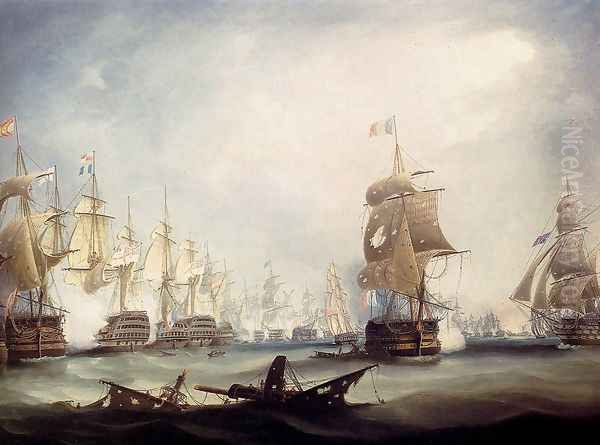
Buttersworth's active naval career concluded around 1800. While serving in the Mediterranean, he was invalided at Port Mahon, Minorca, possibly due to injury or illness sustained during service. This period of convalescence appears to have been a turning point, allowing him the time and focus to dedicate himself more fully to painting. His experiences in the Mediterranean also enriched his visual vocabulary, exposing him to different light conditions, coastal topographies, and vessel types, which would occasionally feature in his earlier works.
The Emergence of a Marine Painter
Upon returning to England and leaving the Royal Navy, Thomas Buttersworth transitioned fully into the life of a professional artist, settling in London. His unique selling proposition was his authenticity. Unlike some contemporaries who relied solely on sketches or descriptions provided by others, Buttersworth painted from a position of deep personal knowledge. He understood how a ship heeled in the wind, how sails were set and trimmed, how cannon smoke billowed and dispersed during battle, and how waves broke against a hull. This intimate familiarity infused his work with a level of detail and accuracy that was highly valued.
His chosen medium was primarily oil on canvas, although he also worked in watercolour. He quickly established himself as a specialist in marine subjects, particularly naval actions and ship portraits. His time coincided with immense national pride in the Royal Navy's achievements, creating a ready market for depictions of famous victories and esteemed vessels. Naval officers, ship owners, merchants involved in maritime trade, and patriotic members of the public were all potential patrons.
Buttersworth's output was prolific. He painted numerous versions of the major fleet actions he likely witnessed, such as Trafalgar and St. Vincent, often varying the perspective or focusing on specific moments within the larger battle. He also depicted smaller engagements, single-ship actions, cruising squadrons, and ships navigating challenging weather conditions. His work wasn't limited strictly to the Royal Navy; he also painted merchant vessels, including the impressive East Indiamen, reflecting Britain's growing global trade network.
His reputation grew steadily, primarily based on the veracity and spirited nature of his depictions rather than through major public exhibitions in his early career, though he did exhibit later. He was appointed Marine Painter to the East India Company, a prestigious title that acknowledged his skill in portraying their large and vital merchant fleet. This connection provided him with commissions and further cemented his status within the maritime art world of the time.
Artistic Style and Technique
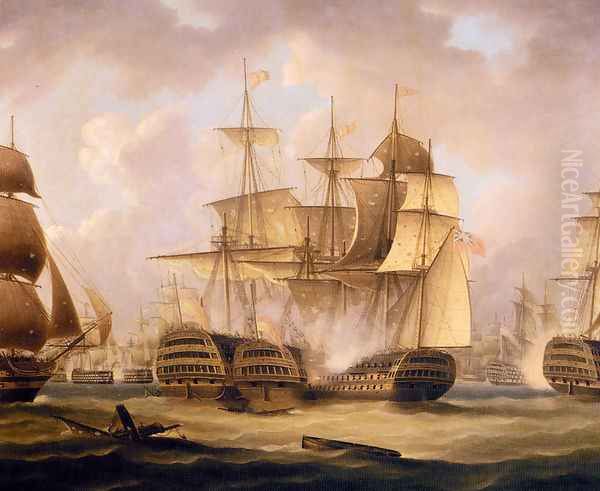
Thomas Buttersworth developed a distinctive and recognizable artistic style. His primary concern was often the accurate representation of the vessels themselves. He possessed a draughtsman's eye for the lines of a hull, the complex arrangement of masts and spars, and the intricate web of rigging. Flags and pennants, crucial for identifying ships and signaling during battle, were typically rendered with care and precision. This commitment to accuracy makes his paintings invaluable resources for naval historians studying ship design and appearance during the period.
His compositions often emphasize the drama and dynamism of the sea. Ships are rarely shown in static calm; instead, they are depicted battling waves, heeling under the pressure of the wind, or maneuvering amidst the chaos of combat. He had a particular skill for rendering water, capturing the movement of waves, the spray kicked up by bows, and the reflections on the surface. While perhaps not achieving the sublime atmospheric effects of a painter like J.M.W. Turner, Buttersworth's seas feel authentic and energetic.
Buttersworth's palette frequently leaned towards cooler tones, with blues, greys, and greens dominating his seas and skies. This often contributed to a sense of realism, reflecting the often-overcast conditions of the North Atlantic or the English Channel. However, he could also employ warmer light, particularly in his Mediterranean scenes or when depicting sunrise or sunset effects. Skies are often active and play a significant role in the overall mood, sometimes featuring dramatic cloud formations or the obscuring smoke of battle.
Compared to the highly influential Dutch Golden Age marine painters like Willem van de Velde the Elder and Willem van de Velde the Younger, whose work profoundly shaped British marine art, Buttersworth's style is perhaps less refined in terms of delicate brushwork but compensates with a robust energy and a focus on narrative action derived from his personal experience. He stands alongside other notable British marine artists of the late 18th and early 19th centuries, such as Nicholas Pocock, another painter with direct naval experience, and Dominic Serres the Elder, who brought a more classically composed approach.
Key Themes and Representative Works
The Napoleonic Wars provided the dominant theme for much of Thomas Buttersworth's output. His depictions of fleet actions are among his most important contributions.
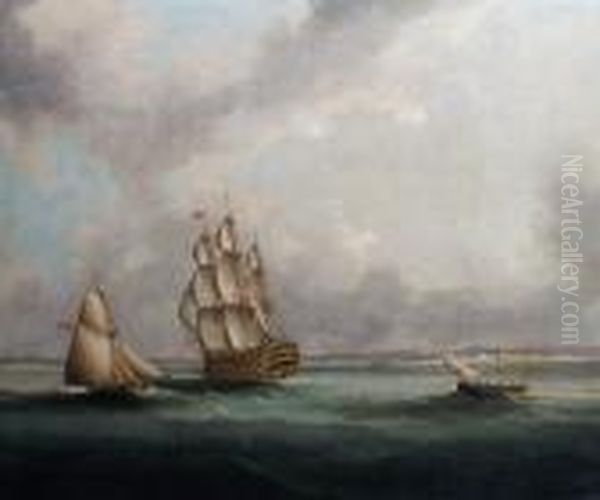
The Battle of Trafalgar: Buttersworth painted numerous views of Nelson's famous victory in 1805. These works typically capture the intense mêlée of the battle, showcasing multiple ships locked in close combat, with damaged rigging, shattered hulls, and dense clouds of gunsmoke dominating the scene. He often focused on key moments involving HMS Victory or other famous participants, demonstrating his understanding of the battle's progression and his ability to convey its scale and ferocity.
The Battle of Cape St. Vincent: His paintings of this 1797 battle are equally significant. They highlight the daring tactics employed by Admiral Jervis and Commodore Nelson, capturing the moment the British line broke through the Spanish formation. The accuracy in depicting the specific ships involved and their relative positions underscores the historical value of his work.
Beyond these large-scale battles, Buttersworth excelled at depicting other maritime scenes.
Ship Portraits: He received commissions to paint specific naval vessels or merchant ships. These portraits required meticulous attention to detail, accurately capturing the unique features of the ship, its sail plan, and often including identifying flags or pennants. These works served as records for owners or commemorative pieces for officers who served aboard.
Shipping in Coastal Waters and Storms: Buttersworth also painted more general scenes of ships navigating coastal waters, entering harbours, or enduring heavy weather. A notable example is The Gale of Plymouth, which vividly portrays ships struggling against powerful winds and high seas, showcasing his ability to capture the raw power of nature and the vulnerability of vessels. Another work, Blockade off Cadiz, depicts the routine yet vital naval task of maintaining a blockade, showing warships patrolling offshore.
His appointment as Marine Painter to the East India Company led to depictions of their large, well-armed merchant ships, known as East Indiamen. These paintings often show the ships in exotic locales or navigating busy shipping lanes, reflecting the global reach of British commerce. These works stand alongside those of other artists associated with the Company, such as William John Huggins.
Patronage, Exhibitions, and Recognition
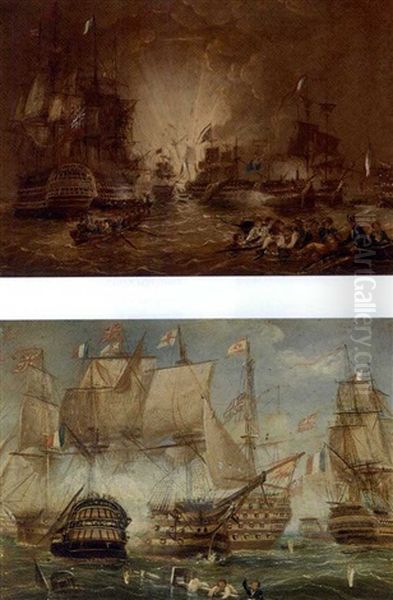
While much of Buttersworth's income likely came from private commissions from naval officers, ship owners, and merchants eager to commemorate their vessels or naval victories, he did achieve a degree of public recognition through exhibitions later in his career. He exhibited works at prestigious venues in London, including the Royal Academy of Arts, the British Institution, and the Suffolk Street Gallery (home to the Society of British Artists). This indicates that his work was seen and acknowledged within the established art circles of the time, even if he wasn't considered part of the artistic avant-garde.
His role as Marine Painter to the Honourable East India Company was a significant mark of professional success. The Company was a powerful entity, and its patronage conferred status. This position likely ensured a steady stream of commissions related to their fleet and operations.
Compared to some contemporaries, Buttersworth's fame during his lifetime might have been more specialized, primarily resonating within naval and maritime communities who appreciated his accuracy and firsthand knowledge. Artists like J.M.W. Turner, who also painted naval scenes (most famously 'The Fighting Temeraire'), achieved far greater artistic renown for their innovative techniques and sublime interpretations, moving beyond literal representation. Buttersworth remained more firmly rooted in the tradition of detailed, descriptive marine painting, closer in spirit to artists like Nicholas Pocock, Dominic Serres, or later figures like Clarkson Stanfield and George Chambers Sr., who also specialized in accurate maritime subjects.
However, the enduring appeal of Buttersworth's work lies precisely in its documentary quality combined with artistic competence. His paintings offer a window into the realities of naval warfare and maritime life in the age of sail, rendered by someone who had lived it. Today, his works are highly sought after by collectors and are held in major public collections, most notably the National Maritime Museum in Greenwich, London, confirming his lasting importance.
The Buttersworth Legacy: A Family Tradition
Thomas Buttersworth's influence extended directly to his own family. He was the father of James Edward Buttersworth (1817–1894), who would go on to become one of America's most celebrated marine painters. Born in London, James E. undoubtedly received his initial artistic training from his father. Thomas Sr. would have passed on his deep knowledge of ships, the sea, and the techniques of marine painting. The stylistic similarities between the early work of James E. and that of his father are evident.
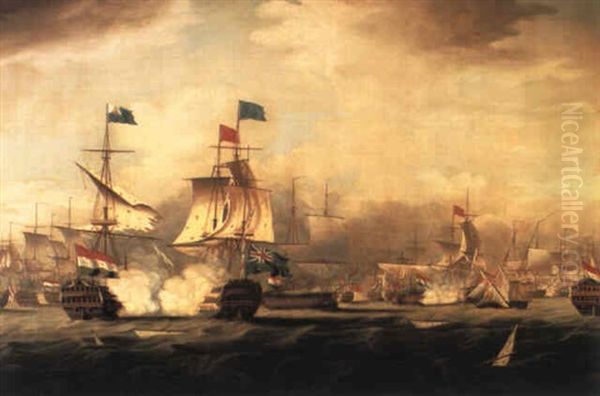
However, their paths diverged significantly. Around 1845, shortly after his father's death, James E. Buttersworth emigrated to the United States, settling in the New York area (specifically West Hoboken, New Jersey). While Thomas Sr.'s work was dominated by the naval history of the Napoleonic Wars and British shipping, James E. found his niche documenting the burgeoning American maritime scene of the mid-to-late 19th century.
James E. Buttersworth became particularly renowned for his depictions of American clipper ships, steamships, and, most famously, yacht racing. The rise of organized yachting in America, particularly the America's Cup races, provided him with exciting and popular subject matter. His style evolved, often becoming lighter, more atmospheric, and focused on speed and elegance, particularly in his yachting scenes, distinguishing his work from the often more robust and historically focused paintings of his father. He collaborated extensively with the printmaking firm Currier & Ives, run by Nathaniel Currier and James Ives, who reproduced many of his paintings as popular lithographs, greatly widening his audience.
While James E. achieved great fame in his adopted country, building upon the foundation laid by his father, Thomas Buttersworth Sr. remained in England, continuing to paint until his death in 1842. The Buttersworth name thus represents a fascinating transatlantic artistic dynasty, rooted in the British naval tradition but branching out to capture the dynamism of American maritime enterprise. Other artists who emigrated or worked in America around this period, contributing to its marine art tradition, include Robert Salmon (who arrived earlier) and James Birch. James E. Buttersworth's American contemporaries in marine art included figures like Fitz Henry Lane and Martin Johnson Heade, though their styles often differed significantly.
Context within British Marine Painting
Thomas Buttersworth operated within a well-established and highly popular genre in Britain. The island nation's identity and security were inextricably linked to the sea, fostering a continuous demand for marine art. The foundations had been laid centuries earlier, heavily influenced by Dutch masters like the Van de Veldes (Elder and Younger), who had even worked in England. Their detailed realism and understanding of maritime subjects set a standard.
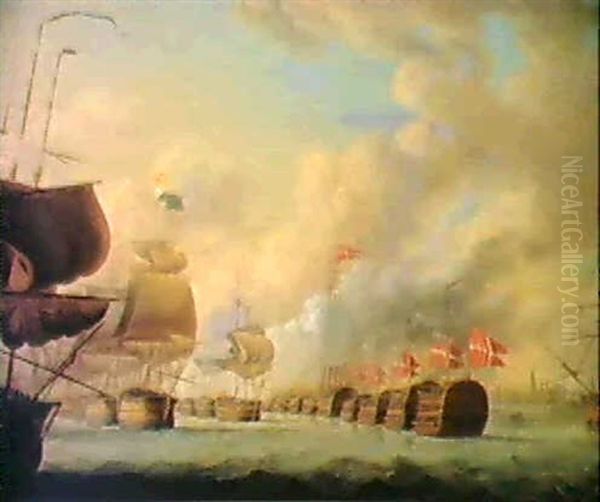
By the late 18th and early 19th centuries, a distinct British school of marine painting had flourished. Dominic Serres the Elder, appointed Marine Painter to King George III, brought a degree of classical composition to naval scenes. Charles Brooking, though his career was short, was admired for his delicate handling of light and water. Nicholas Pocock, like Buttersworth, had served at sea and brought authenticity to his depictions of naval battles from the American Revolutionary War and Napoleonic Wars.
Buttersworth's specific contribution lies in his focus on the Napoleonic naval campaigns and his ability to convey the action and detail based on personal experience. He was less concerned with the picturesque or the sublime than some contemporaries, focusing instead on the accurate portrayal of ships and events. William John Huggins was another contemporary who specialized in ship portraits and held royal appointments. Later artists like Clarkson Stanfield and Edward William Cooke continued the tradition of detailed marine painting into the Victorian era, often with a greater emphasis on dramatic seascapes or harbour scenes.
Buttersworth's work provides a crucial link in this tradition, representing the generation that directly experienced the height of naval conflict in the age of sail. His paintings offer a perspective distinct from the more romanticized or atmospheric interpretations that would gain prominence later in the 19th century. He captured the workaday reality and the dramatic intensity of naval life with an authority born of experience.
Historical Significance and Lasting Appeal
The primary significance of Thomas Buttersworth's art lies in its value as historical documentation. His paintings provide detailed visual records of British warships and merchant vessels of the late 18th and early 19th centuries. For naval historians and model makers, the accuracy of his depictions of hull forms, rigging, sail configurations, and flags is invaluable. His battle scenes offer insights into naval tactics, the appearance of specific engagements, and the brutal reality of combat at sea during the Napoleonic Wars.
Beyond their documentary worth, his paintings possess considerable artistic merit. He was a skilled composer, capable of organizing complex multi-ship scenes into coherent and dramatic narratives. His handling of light and water, while perhaps not revolutionary, was highly competent and effective in conveying mood and atmosphere. The energy and dynamism present in his best works capture the excitement and danger of maritime life.
Today, Thomas Buttersworth is recognized as one of the key figures in British marine painting of his era. His works are appreciated by collectors of maritime art, naval historians, and museum curators. Major maritime museums around the world, particularly the National Maritime Museum in Greenwich, hold significant collections of his paintings, ensuring his work remains accessible for study and appreciation.
His legacy is twofold: firstly, the substantial body of work that vividly chronicles a crucial period in British maritime and naval history; and secondly, the artistic lineage passed down to his son, James E. Buttersworth, who adapted the family tradition to a new context in America. Thomas Buttersworth remains a testament to the power of art when informed by direct experience, capturing the world of wooden ships and iron men with enduring skill and authenticity.
Conclusion: A Sailor's Eye, An Artist's Hand
Thomas Buttersworth occupies a vital place in the history of marine art. His life journey from active seaman in the Royal Navy during its most testing period to a respected professional painter provided him with a unique perspective. He translated his intimate knowledge of ships and the sea into canvases that are both historically accurate and artistically compelling. His depictions of the great naval battles of the Napoleonic Wars, ship portraits, and scenes of maritime life serve as enduring records of Britain's age of sail. While perhaps overshadowed in broader art history by innovators like Turner, Buttersworth's dedication to truthful representation combined with dramatic effect secured his reputation within his specialized field. Through his prolific output and the continuation of the family tradition by his son James E. Buttersworth in America, his influence persisted, leaving a rich legacy for those fascinated by the majesty and peril of the sea.